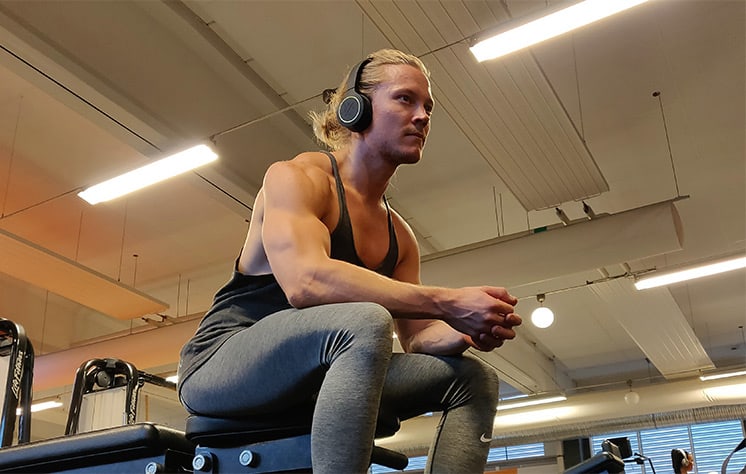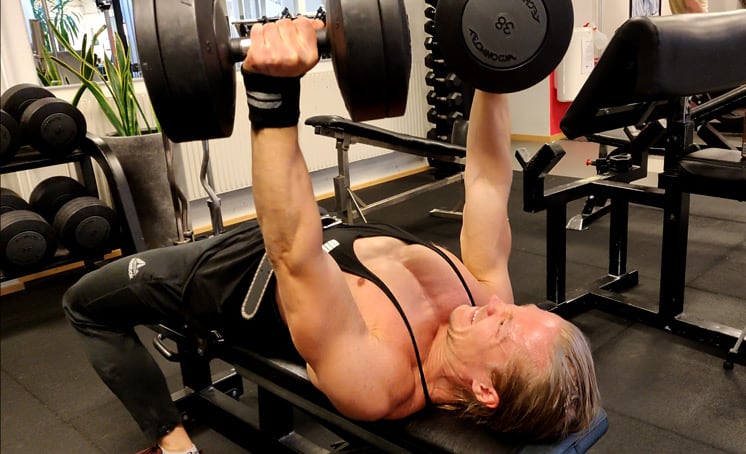
It’s long been believed that once you go into a bulk you should largely increase the total amount of reps that you do in a workout, and also do higher rep training on every exercise as this will lead to the most muscle growth. But is this really true? Well I did some research and here’s what I learned:
How many sets and reps to do when bulking? First and foremost this depends on training experience. But, a good place to start for a beginner is to do 35-90 reps per week per body part, using weights that are between 70-85 % of your 1RM (5-15 reps per set). Overtime as you get more advanced you will need to do more total reps per workout and week.
The amount of sets and reps you do when training is known as your training volume. How much training volume you do largely dictates how much muscle you put on. What’s important to know however, is that you can do too much and too little.
So, in this post I’ll cover the importance of getting your training volume right when bulking, as this will ensure that you put on more muscle as opposed to fat. So, let’s get to it.
Table of Contents
How Many Sets And Reps Should You Do When Bulking?
For a beginner a good target is to do 35-90 reps per body part per week, using weights that are between 70-85% of your 1RM (rep max).
Now I’m sure you’re wondering, why this large range?
Well, one thing to take into consideration is that if you’re training with heavy weights, also called high intensity (like you do in the ShredSmart Program for example), of let’s say 6 reps per set using 85% of your 1RM. Then you should do fewer reps per week or you won’t be able to recover.
But, if you train with a more moderate intensity, such as 10-15 reps per set using 70-75 % of your 1RM, then you can be on the higher end of the weekly volume amount.
So, an example of this could be:
High intensity training program:
3 sets of 6 reps on Bench press with 2 weekly workouts = 36 reps per week for chest, triceps and front shoulders
Low-moderate intensity training program:
3 sets of 15 reps on Bench press with 2 weekly workouts = 90 reps per week for chest, triceps and front shoulders
As you can see, the difference between these training programs is that the first one with high intensity will have you do far less volume, but more intensity. While the second one will have you do way more volume, but less intensity.
Both of these ways to program will in most cases lead to very similar muscle growth. However, I would argue that the first choice with higher intensity will be a more effective workout, because higher intensity workouts are more effective and efficient in nature.
It’s also been shown that for a beginner, especially if you’re not that fit already, such as from practicing sports etc. then going the high intensity route is going to be favorable for your recovery, which will then lead to better muscle growth in the beginning. This is one of the reason why the Kinobody programs work so well.
Weekly Sets And Reps is More Important Than Daily Sets And Reps
When measuring training volume, it’s much better to look at it weekly rather than daily. The reason for this is because of training frequency. It’s been shown repeatedly in research that a higher training frequency, at least for beginner to intermediate trainees leads to better muscle growth.
In other words, training a movement 2 times per week, but for fewer sets and reps each time is better than training only 1 time per week with more sets and reps. This is because a higher training frequency with less training volume and intensity per workout leads to better:
- practice of the lifts; and
- recovery because of smaller boluses of work spread out over the week.
If you want to read more about training frequency, check out this post next.
Focus Mostly on Compound Movements And Free Weights
Make sure you use compound exercises, mainly free weights such as bench presses, pull-ups, rows, overhead presses, squats and deadlifts etc. as these exercises will give you the most bang for your buck, while also ensuring that your whole body gets developed as one.
Focus on Progressive Overload Over Maximum Volume
This is very important. If you want to gain muscle quickly, while staying injury free, focusing more on progressive overload rather than doing maximum amounts of volume is very smart. Let me explain what I mean with this:
In research it’s been shown that training volume is the main driver of muscle growth, and that more training volume typically leads to more muscle growth. However, you got to be very careful not doing too much volume too soon.
If you do too much volume to soon, you risk overtraining, injuries and actually running out of a reserve of training volume to do later in your training journey when you might need it.
Here’s the thing that almost all experts agree on, progressive overload is more important than just “performing volume”. This means that if a person is not performing better (getting stronger) in the gym overtime, they’re likely not getting that much bigger either.
In fact, muscle growth always follow improved training performance and not the other way around.
And even though more training volume generally means improved training performance, it’s still safer to train with lower volume than what you truly can handle, for the reasons just mentioned.
One way to see if you’re doing too much volume, is if you’re adding training volume but not seeing a performance increase. This means that you’re adding volume to quickly and you should back it down to more reasonable levels for what your body can handle and recover from.
Increase Your Weekly Training Volume Only When You Need To
Your goal should be to increase your weekly volume when you’re no longer making progress on a lift. With that said though, only increase your volume if you’re recovered.
If you’re not recovered then that’s the reason why you stopped making progress. Which means that if you were to add more volume at this point, it would be like adding gasoline to the fire.
So, before you increase your volume make sure you check for these things:
1. Check your diet – Most of the time the reason people no longer are making strength gains is because they’re no longer gaining weight and muscle. If you try to gain strength in a calorie deficit for example, then at some point you will plateau, simply because there’s not enough food coming in to support recovery and further growth.
2. Change the exercise that’s stalling – One thing that I’ve learned from Brad Schoenfeld’s book The Max Muscle Plan is that trying to increase a lift that’s been stalling for a long time almost never works.
Doing the same exercise over and over again trying to progress, brings about a condition called monotonous overtraining, which Brad explains as a maladaptation of the neuromuscular system that appears when you’re doing the same exercises in the same fashion for long periods of time.
Not only that, your mind is also going to play a huge role when you’re stalled. If you’ve been stalled for a long time chances are that you’re no longer excited to do that movement, you may actually be afraid that you won’t be able to progress on that exercise, and in such a frame of mind it’s incredibly hard to make progress. Where your mind goes your body follows!
So if you’ve been stalling for a while, do another similar exercise for a while, such as incline bench press instead of regular bench press and so forth.
3. Check your sleep – It’s when we’re sleeping when most of our recovery take place. So, make sure you get 7-9 hours of quality sleep per night, by doing so you can be sure that it’s not your sleep that are setting your progress on hold.
4. Reduce daily stress – Reducing your overall daily stress as much as possible is important if you want to stay away from a strength training plateau.
It’s been shown that all stressors put on the human body fills up the same cup. This means that daily stress fills up the same cup as your training stress, and hence affect your recovery and performance negatively.
So, if you train with the same volume as you always have, you eat well and enough, you’ve changed up your exercises when stalled, your sleep is on point and you’re not having a more stressful lifestyle than usual, but you’re still stalled in your lifting, then increasing your volume on the stalled lift/muscle group with 10-15 % is a great idea to continue making progress.
What’s Next?
Even though training volume is a large part of setting up a successful training program, there’s still so much more that goes into a well set-up training plan than just the amount of sets and reps you do.
You have progression models, rest times, lifting tempo and not to speak about everything surrounding the diet that you must have in check if you want to build a lot of muscle to get the physique you’re after.
But you can do it, there’s no doubt about it! All you need is a well set up plan that you can follow.
And my recommendation would be to get your hands on a well made step by step guide!
Personally I love the ShredSmart Program, as I’ve used it myself to build the physique of my dreams. You can learn more about the program here.
Go get it, your physique is waiting!
Related Questions
How many sets should I do per workout? You should first look at your total weekly number of sets and then divide that amount into how many workouts you want to do for a specific muscle group/movement. If you’re looking to train chest twice per week (which is a good idea) then divide your total weekly sets with 2 and place this number on each of the chest workouts.
How many days should I rest when bulking? I recommend that you train 3-4 times per week, focusing on either full body workouts or upper/lower split workouts with rest days in between your workout days.
This way you will get 3-4 rest days per week which is extremely beneficial for quick strength gains and muscle growth, at least in the beginner to intermediate stages of your lifting career. The reason it’s beneficial with rest days between workouts is that you’ll refresh your central nervous system which will enable you to push hard in the gym each time you’re coming in for your workouts.

